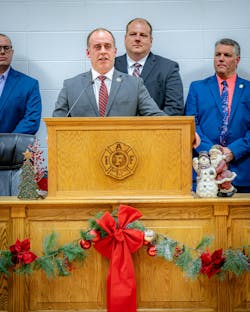Milwaukee Fire Department 150th Anniversary: Health & Wellness: Talking the Same Language
When Milwaukee Fire Department (MFD) Fire Chief Aaron Lipski told Firehouse that the department has done “more collaboration and change management than ever before,” his remark applied to numerous facets of the MFD’s construction and operations, but the comment might just as well have been a statement about its approach to the health, wellness and safety of the department’s members. From nurturing a greater recognition of MFD’s chief officers’ own health, to a never-more-substantial connection with members, to a collaboration with the union that might be the envy of the whole U.S. fire service, the foundation of the work on wellness, both physical and mental, is laser-focused.
Culture shock
Ali Ekman, who is MFD’s health & safety manager, joined the department in April 2023. She did so after serving for 10 years as point person for a vendor’s work with the department, including such things as health appraisals and clinics. On Ekman’s first day as an employee of the department, she believed that she had a firm grasp on the health and wellness of municipal employee needs, in general, and on MFD’s members’ circumstances, in particular. It wasn’t long before Ekman experienced a “crazy culture shock” that opened her eyes to how engagement—hearing the department’s voice, as she put it to Firehouse—is so vital to addressing the health and wellness needs of firefighters.
In earlier days, the department certainly covered the Xs and Os of member health and safety research: doing the rounds, going to firehouses to check in with members, getting information. However, that work didn’t result in a deep grasp of matters, to the extent that many members told Ekman that they were unimpressed with the efforts, including never hearing from leadership about what would result from their explanation of their circumstances.
“I am very intentional with every single interaction that I have with members,” Ekman says. “I always make a point to report back to them, even if I initially don’t have an answer or can’t fix the concern that they raised.”
She says it’s all about meaningful conversations, which she believes motivates members to start to engage.
From the chiefs down
Unsurprisingly, throughout the evolution of the relationship between members and the department, leaders embraced the importance of building trust. The work that’s been put forth toward accomplishing this has been multifaceted.
One important element was MFD chiefs’ first participation in the Milwaukee Fire Truck Pull, which is hosted by the nonprofit Ignite the Spirit, which supports MFD firefighters and their families.
“Nobody believed it,” Ekman shares. “A bunch of chiefs pulling a fire truck.”
The chiefs team, which she joined, didn’t finish among the Top 5, but it created a “fun energy” and helped to show members that department leadership wanted to bridge any disconnects that were either real or perceived.
Ekman’s participation fed into that, too. She believes that it helped with her credibility among members and that they feel that she’s invested in their well-being.
Her credibility—and that of her work on behalf of members’ health and wellness—also has been strengthened by department leaders empowering her and her efforts to raise the bar from Day 1.
“From administration, to members, to the union, to the benefits department, these groups often can be so disconnected,” Ekman explains. “We’re all working toward the same thing, and the members are starting to feel that, believing that we’re in it for all of the right reasons and we’re working as hard as we can to advocate for the things that they need.”
Lipski terms it a commonality of mission. Included in this is the Milwaukee Professional Firefighters Association IAFF Local 215.
“We all agreed that the mission is taking care of members,” Lipski tells Firehouse.
Quickly falling by the wayside was the contention and undercutting that could dominate in the past.
The MFD & the Union
Local 215’s president is Capt. Eric Daun. He joined the MFD in 2012. He became a member of the union’s executive board in 2016, was elected vice president in early 2021 and then was elected president in August 2021.
“For decades, we had a toxic labor-management relationship,” Daun says. “As times evolve, you have to be willing to collaborate more than you did in the past.”
The launch of a new era occurred when Daun took over the union presidency and he and Lipski met for coffee to discuss the ramifications of a BLS ambulance company’s decision to discontinue operations in the city and what the MFD’s takeover of that service meant for the department’s members, a task for which the members weren’t ready, Daun says.
“We sat down for coffee with a mutual friend—who almost mediated the meeting—and we came to a resolution that ‘We’re here for the members. Let’s do this together, instead of fighting, because fighting all of the time just never works, because you always are at your wits’ end.’”
Lipski agrees. He and Daun were “fit to be tied,” not only over the BLS ambulance matter but in regard to the department’s and union’s relationship up to that point.
The work that Lipski, Daun, the MFD and Local 215 have carried out that puts members’ physical fitness and mental health ahead of everything else is exemplified in the joint efforts regarding an alcohol and drug abuse policy. Training on alcohol and drug abuse used to be a one-and-done proposition. Now, the commitment is ongoing, and that wouldn’t be possible without the help and cooperation of the union.
The relationship always had its times of productivity, Lipski says, but it has been strengthened, to the point that he considers the two organizations “real partners.”
Ekman agrees. “It’s inspiring to watch the president of the union and Chief Lipski collaborate and listen to each other and work on solutions,” she says. “It just shows how much that they are in it for the right reasons.”
Next up
Despite numerous recent successes, the MFD isn’t resting on its laurels when it comes to member health and well-being. For example, work is underway to expand the number of visits that members may have with the Employee Assistance Program, which currently sits at three per year. If that requires the department to dig and solicit for more funds and/or grants to pay for such a move, then that’s what will be done.
The department also is looking more closely than ever at the entire life cycle of a firefighter. Ekman says the department can improve immensely in providing help to people during transitional periods, such as going from the field to an administrative position.
“I don’t believe that anybody is prepared for how lonely an administrative position can be,” she says. “People who make such a switch very well might have figured that things would be different, but they came from a world where they had a firehouse family, and that changes with change.”
The same applies regarding retirement. The department wants to make sure that members “don’t just fall off the radar.”
“Whether that’s performance coaching or transition coaching or whatever the program, we must keep taking care of these people,” Ekman stresses. “We must stay connected and keep bringing these people back to their ‘family.’”
Daun relates it as being “proactive” in watching over members.
“If I have a member call to say they’re struggling, I can call the chief, and he’ll release one of the department’s peer support people from duty to check on the person,” Daun tells Firehouse, “and if one of our head peer supporters has a hard time getting hold of somebody, they’ll call me, and I’ll go to the member’s house to make sure they’re OK.
“A lot of it is bringing back the brotherhood and sisterhood in solidarity,” he adds.
Will the biggest gains be immediate? No.
“If we’re going to do something, we’re going to do it right,” Ekman explains, “which means, sometimes, slow-rolling things, to make sure that all of the key players are involved.”
However, the MFD firmly believes that careful approach also works in the moment. By creating, as Ekman puts it, a “fabulous, healthy peer pressure,” all of the department’s endeavors regarding member health and well-being rather sell themselves. She says that she and her collaborators aren’t really required to do a lot of heavy lifting on their end for the purpose of convincing people to embrace their own betterment.
“Can those who are leaning on the side of skepticism really say no when so many other people keep saying, ‘Hey, this is so cool!’?”
About the Author
Rich Dzierwa
Managing Editor, Firehouse Magazine
Rich Dzierwa joined Firehouse Magazine in 2019 after four tenures with other publications. He was editor-in-chief of Consumers Digest/ConsumersDigest.com and of trade magazine Cutting Tool Engineering. He served as the consumer products reporter for BridgeNews and began his publishing career with an 11-year tenure at Appliance magazine, where he rose to managing editor after serving in other roles. Dzierwa's experience with consumer products, including furnishings, appliances, electronics and space design, has transferred to his Firehouse work regarding the magazine's Station Design columns and the Station Design Awards. Previous work also has contributed to his supervision of several surveys of fire service/EMS members, to produce unique reporting for Firehouse's audience. Dzierwa earned a bachelor's degree in English from Columbia College Chicago.


